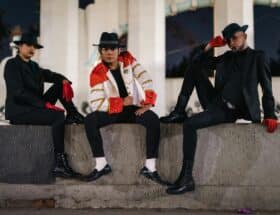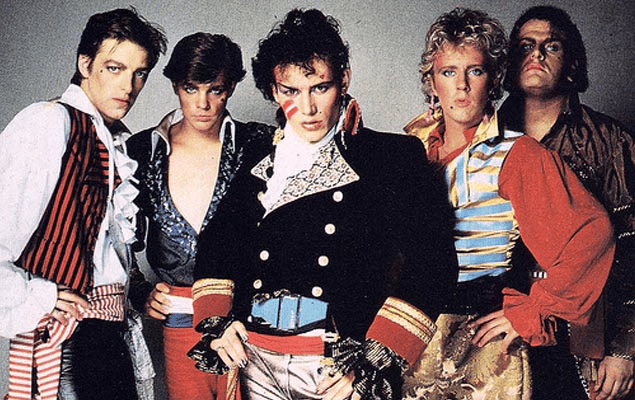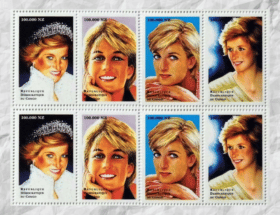The Economy Boom
In the 1980s, fashion was influenced by the western economic boom. Youth culture stopped hogging the scene as the teenage market lost impetus. The dominant market was getting older and was also financially secure. Demographics changed the face of society. People were living longer and seemed to act younger at the same time. Old industries died, while new technologies developed and boomed.
Ronald Reagan and his wife Nancy Reagan in the USA celebrated presidential success with a style that used fashionable conspicuous clothes and social events to display the affluence of American society to a world audience.
The world was in flux; ever changing. The USSR relaxed rules and opened up to private enterprise. The Berlin wall came down and other eastern bloc countries craved western clothes and liberation.
In Britain Thatcherism promoted privatization and the idea that greed was good was given credence. Temples to modern living, shopping malls sprang up throughout Britain. Western society consumed and consumed.
Right - Margaret Thatcher in her power suits. Fashion history records the power suit and dressing for success as the symbol of the 1980s. The best know icons of 1980s fashion for power dressing were Mrs Thatcher and The Princess of Wales, Diana.
Designer labels and branding gained impetus. Brand names became status symbols for sports gear and sportswear, perfumes, electrical equipment, cars and fashion designer goods such as clothing, bags, luggage, scarves and spectacles.
The appearance of affluence was reinforced by access to designer label goods.
By the mid-eighties tills rang not with cash, but the increasing use of credit cards. It was all such a relief to the consumer to be able to spend and actively be encouraged to consume after years of recession. Clothing purchases soared. Interiors were decorated. Showing wealth was superficially powerful.
Advertiser's Acronyms
Advertisers gave a whole range of acronyms to groups of consumers in the 1980s. Looking at these acronyms does help to understand how advertisers identified recognisable groups in society in the consumer driven world of marketing 1980s fashion.
A typical acronym was DINKY which described an increasing section of society, the couples not necessarily married, but who were 'Double Income No Kids Yet.' The Dinky was the type of consumer that might be targeted for spending on fashion and status symbols like perfume, label goods and stylish kitchen items that might never be used. The couple could even encourage each other in achieving their lifestyle of aspiration. Other labels advertisers favoured include Empty Nesters, Grey Panthers, Ladettes and Tweenies. The guppies term has since been hijacked by other groups.
Acronym Table for 1980s Fashion and Marketing Terms
Yuppies - Young Urban Professionals
Yummies - Young Urban Mother
Dinkies - Double Income No Kids
Sinkies - Single Income No kids
Minkie - Middle Income No kids
Poupie - Porsche Owning Urban Professional
Swell - Single Woman Earning Lots Of Loot (Miss Yuppie)
Guppies - Greenpeace Yuppies (The original meaning of the term)
Bobo - Burnt Out But Opulent
Woopie - Well Off Older People
Jollies - Jet Setting Oldsters With Lots Of Loot
Glams - Greying Leisured Affluent Middle Aged
Deccie - D.I.Y Decorators Who Drag Stipple and Marble
Splappie - Stripped Pine Laura Ashley People
Drabbie - Ethical Urban Quaker With Anti And Pro Views
Dockney - East Docklands London Yuppie
Tweenie - Between 5 And 12 Years Old
Ladettes - Young Women Who Act Like Loutish LadsGrey Panthers - Senior Citizens With OpinionEmpty Nesters - Couples Whose Children Are Grown Up And Away
Yuppies
Yuppie was a 1980s acronym for 'Young Upwardly Mobile Professional Person'. The word was coined by the advertising industry to capture the essence of a particular type of work hard, play hard, ambitious minded city career person of either sex. The hectic lifestyle of a yuppie meant that after long hours of work, rare free time was spent in a self indulgent way frittering away the cash earned on anything, from expensive make up and perfume, to a bottle of fine champagne. Conspicuous wastage was part of the attitude.
For day Yuppies sported wide shouldered jackets and for weekends they wore a Barbour to effect a country aesthetic or a ball-gown to assume the appearance of a more advantaged lifestyle.
Women Dress for Success
One of the strongest looks of the 1980s was power dressing. After John Molloy wrote his book Women Dress For Success in 1975, corporate America took it to heart and women began to abandon the incomplete look of mismatched skirt, sweater or blouse for a full jacketed sober suit. Soon the concept came to Britain and the rest of Europe followed.
The Perfect Suit for the Corporate Ladder
The aim of female devotees was to rise the corporate ladder. John Molloy promoted the idea that the simple tailored wool suit in neutral navy or slate blue grey, worn with non sexual blouses, imitated uniform of rank, which by design was authoritative.
From research he did with specific social groupings, he maintained that inferiors and clients accepted the word of a female dressed in a suit with better grace than if she were wearing a fashion outfit in an exotic fashion colour that highlighted her sexual allure.
In other words sober dressing enabled a women to be taken seriously like a suited man might be and helped her shine in the workplace enough to get promotion rapidly. This led to the concept of power dressing and its influence on all forms of fashion when the shoulder pad dominated every female top garment, from power suits to knitwear, to T-shirts to bed attire.
Tom Wolfe's Book - The Bonfire of the Vanities
Ever the expert at summing up the zeitgeist, Tom Wolfe penned his now famous Dickensian novel 'The Bonfire of the Vanities' which captured the notion of money fever and the use of clothing to indicate the mood of people, attitudes and places.
Do read this book if you want to experience the spirit of the era.
*This post contains affiliate links, so we may earn a small commission when you make a purchase through links on our site at no additional cost to you.



